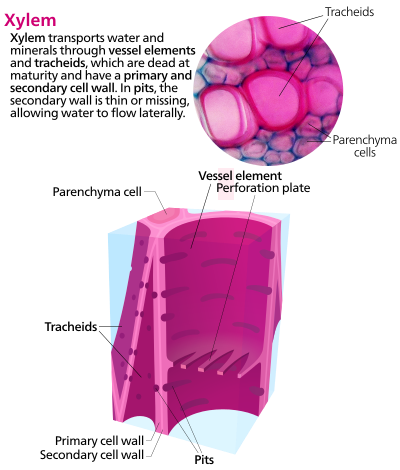
PUMPA - SMART LEARNING
எங்கள் ஆசிரியர்களுடன் 1-ஆன்-1 ஆலோசனை நேரத்தைப் பெறுங்கள். டாப்பர் ஆவதற்கு நாங்கள் பயிற்சி அளிப்போம்
Book Free DemoWe see that water from the ground is pumped to the upper storage tank through a pipe in a house. Also, it is distributed to all regions of the house through various pipelines. Similarly, the transport system of plants moves the energy stores (ATP) from the leaves and the raw materials from the roots to various parts of the plants in two different pathways constructed as independently organized conducting tubes.
- The tissues associated with the conduction of water, minerals and food materials in plants are called vascular tissue.
- Plants with a well developed conductive system are thus called vascular plants.
The transport system is also known as the vascular system and comprises of two conducting vascular tissues known as the xylem and phloem which conduct the water, minerals and the products of photosynthesis respectively.

Vascular tissues - Xylem & Phloem
Transport of water and minerals:
The water and minerals absorbed by the plant's root hairs are transported by the complex permanent, conducting tissue xylem. It conducts sap (water and mineral) nutrients in only an upward direction from root to leaves (unidirectional). This tissue also provides mechanical support to the plant. The cells of the xylem have thick lignified walls, and many of them are dead. It is a heterogeneous tissue consist of various elements. They are further divided into four components.
- Xylem Tracheids
- Xylem fibres
- Xylem parenchyma
- Xylem vessels or trachea

Xylem cells
Xylem tracheids:
- They are the chief water-conducting elements of the xylem. They have a large lumen without any content.
- Tracheids are one of the non-living components (without cytoplasm and nucleus) of the xylem.
- Due to lignification, the cells cannot exchange the essential materials with the outside environment. These cells lose their living characters at maturity and become dead.
- It helps to conduct water and nutrients from the root to the leaf in the upward direction.
- It provides mechanical support to the plant.
Xylem fibres:
- These are elongated dead cells with sharp ends and thick cell walls.
- Their walls are thick due to the presence of lignin.
- These are fibres associated with xylem and supportive in the functioning of xylem.
- It helps to conduct water and nutrients from the root to the leaf.
- It provides mechanical support to the plant.
Xylem vessels:
- They are arranged in longitudinal series in which the partitioned walls (transverse walls) are perforated, and so the entire structure looks-like a water pipe.
- These are also dead cells with lignified secondary walls, and hence it does not have protoplast.
- Vessels are efficient in conducting water due to the presence of perforations. They transport water and minerals vertically, i.e. from root to leaf transport.
- It also provides mechanical strength to the plant.
Xylem parenchyma or wood parenchyma:
- These are the only living cells of xylem with thin cell walls. The cells are with abundance of cytoplasm and a prominent nucleus.
- It helps store food such as starch and fatty substances like oil.
- It helps in the lateral (sideways) conduction of water.
Important!
Tracheids and vessels together called tracheary elements because they conduct sap.
Click here to recall about xylem
Reference:
https://commons.wikimedia.org/wiki/File:Xylem_cells.svg